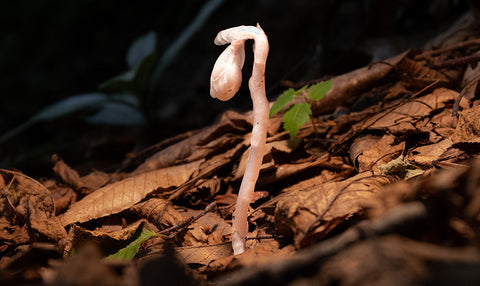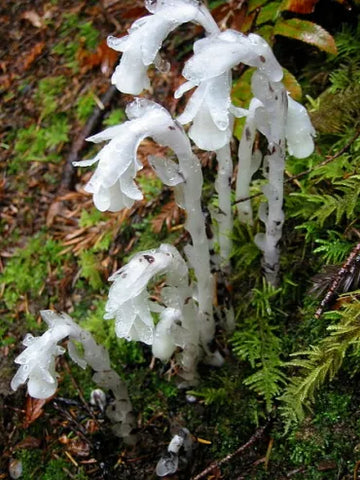The Magic Of Ghost Pipe
Written by: Norianna Diesel

Monotropa uniflora, also known as ghost pipe or Indian pipe, is a perennial from the Ericaceae family that makes its presence known by a white translucent fruiting body. This is not your typical plant, as it does not photosynthesize, rather, it obtains nutrients from a mycorrhizal fungi, with research showing that the primary relationship is with the Russula fungi. In typical mycorrhizal relationships that you see between various fungi species and trees, there is always some sort of nutrient exchange. Monotropa uniflora however, doesn't give anything back to the Russula fungi, rather it simply takes the nutrients it needs, thereby classifying it as a symbiote.
Ghost pipe is native to temperate regions of Asia, North America, and northern South America, but showing up sporadically with large gaps between regions of growth. You will find ghost pipe growing in shaded woods with rich, moist soil. Often this ghostly flower shows itself as a waxy translucent white, but sometimes it will have black flecks, or even a pale pink coloration, with a rare variety showing a dark red color.
There are so many things that really make this plant stand apart, one of them being that when you handle the flower, it can easily dissolve, much like ice will when held. There is one curved downward pointing bell-shaped flower for each stem that is nonodorous. Though unique, these flowers are still pollinated by bees, and once pollinated, the flower points upwards and forms an oval seed capsule. Once the seed capsule has fully matured, the seeds then are dispersed through the wind, and the plant dries up, turns black, and shrivels down.
Mythology:
It is not hard to imagine that the native peoples who lived amongst ghost pipe would create mythology and legends surrounding this super unique plant. The energy coming off of this flower beckons one to take a seat, and enter into the mythical realm of plant spirits. I have heard that ghost pipe is an elusive plant, showing itself only when it wants to be seen, much like American ginseng only makes itself known when ready.
One beautiful legend surrounding ghost pipe is that from the Cherokee peoples. The legend is copied and shared below:
Before selfishness came into the world, which was a long time ago, the Cherokee happily shared the same hunting and fishing lands with their neighbors. However, everything changed when selfishness arrived. The men began to quarrel with their neighbors.
The Cherokee began fighting with a tribe from the east and would not share the hunting area. The chiefs of the two tribes met in council to settle the quarrel. They smoked the tobacco pipe but continued to argue for seven days and seven nights.
The Great Spirit watched the people and was displeased by their behavior. They should have smoked the pipe after they made peace. The pipe is sacred and must be treated with respect. He looked down upon the old chiefs, with their heads bowed, and decided to send reminders to the people.
The Great Spirit transformed the chiefs into white-gray flowers that we now call “Indian Pipe.” The plant grows only four to ten inches tall and the small flowers droop towards the ground, like bowed heads. Indian Pipe grows wherever friends and relatives have quarreled.
Next the Great Spirit placed a ring of smoke over the mountains. The smoke rests on the mountains to this day and will last until the people of the world learn to live together in peace. That is how the Great Smoky Mountains came to be.
— Lloyd Arneach (Eastern Band of Cherokee)
American Indian Magazine
Winter 2010. “The Storyteller’s Art: Sharing Timeless Wisdom in Modern Times” by Anya Montiel
Pages 34-39

History:
This elusive and beautiful flower has been studied and scientifically pondered upon at least as far back as 1821, when William Hooker, (the founder of the Royal Botanic Gardens in Kew) and his son Joseph, hypothesized that ghost pipe could be either a parasite on tree roots, or like fungi, absorbing nutrients from decomposed organic matter. In the early 1840s, Thomas Rylands discovered that the roots of ghost pipe were not actually connected to trees, but rather to the mycorrhizal fungi. Then, in the 1960s, Eric Björkman and Steve Trudell were able to prove that ghost pipe had a parasitic action towards the fungi and tree symbiotic relationship.
Emily Dickinson, the great American poet, was incredibly fond of ghost pipe flower, and her book Poems, published posthumously in 1890, had an illustration of ghost pipe on its cover!

Historical Medicinal Uses:
Most herbalists typically use the root of the ghost pipe plant, although once the root is harvested, it disrupts its ability to flower again, and in certain endangered areas should be avoided.
Historically, herbalists have used the ghost pipe roots for its sedative, antispasmodic, and diaphoretic effects. Ghost pipe has been popular to use to manage neuronal disorders like psychosis, acute anxiety, nervousness, irritability, restlessness, and convulsion episodes. It has also historically been used for afflictions such as: epilepsy, chorea, febrile disease, emotional and mental pain, and nerve pain.
Rose water combined with ghost pipe juice has been used for ulcers, gonorrhea, inflammation of the bladder, and even ophthalmic inflammation.
One unique effect of ghost pipe is its ability to neutralize the effects of an overly strong or bad psilocybin trip. It may also help in repressing certain traumatic memories that could then trigger anxiety and panic attacks.
The Cherokee Indians used ghost pipe as an anti-convulsive, giving the ground up roots to people during an epileptic fit or convulsion. They also crushed it up and rubbed it on bunions or warts, and the juice was used to wash sore eyes.
The Cree Indians used ghost pipe as a toothache remedy by chewing the flowers.
The Mohegan Indians used ghost pipe to reduce the effects of fevers and pain.
The Thompson Indians in British Colombia used a poultice of ghost pipe for sores that would not heal.
The Potawatomi Indians used an infusion of ghost pipe root as a gynecological aid.

Other notes:
We have possibly one of the world's only freeze-dried ghost pipe flower spagyric tincture right here in our online Apothecary. We have a special relationship with a wild-harvester in Virginia who sustainably harvested the ghost pipe flowers, kept them on ice, and overnighted the flowers to us. Once these flowers arrived in our laboratory, we put them in our freeze-dryer to ensure the freshest preservation of this beautiful flower. Later, the freeze-dried material was turned into a spagyric tincture, stretching the medicinal virtues of the plant in the furthest way possible. This spagyric tincture is one that gets recommended the most when we do live events and are running a booth. Many people come to our booth with complaints of anxiety or nervousness, and we let them know that ghost pipe has historically been used to help both of these complaints.
The first time both Phoenix Aurelius and I saw ghost pipe flowering in its natural environment was when I had taken him to Asheville, NC in 2021. On our way home, we stopped by Grandfather Mountain, and while walking in the woods near a little parking lot, we spotted this mysterious translucent flower. At that time, I wasn't even aware of what it was that I was seeing, but later came to find out that we had indeed stumbled across some ghost pipe! I look forward to spending more time in the Appalachian forests, and being able to take my time sitting and connecting in with this special flower. Her presence really calls forth a certain patience and stillness, and it is no surprise to learn that she is a master at calming anxiety or nervousness.











